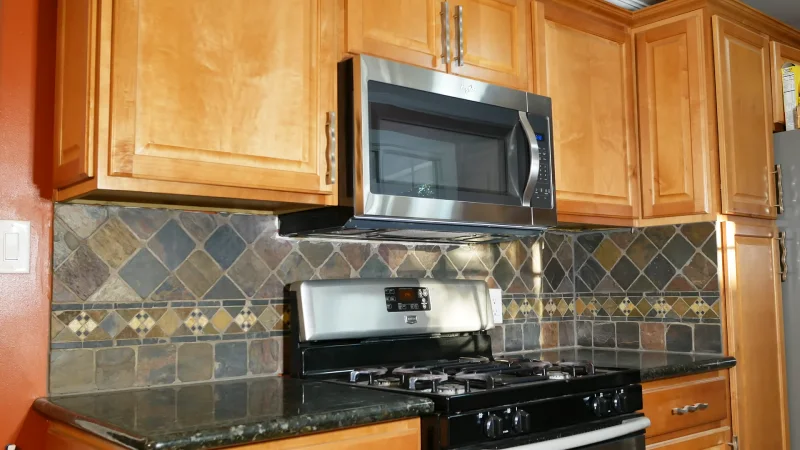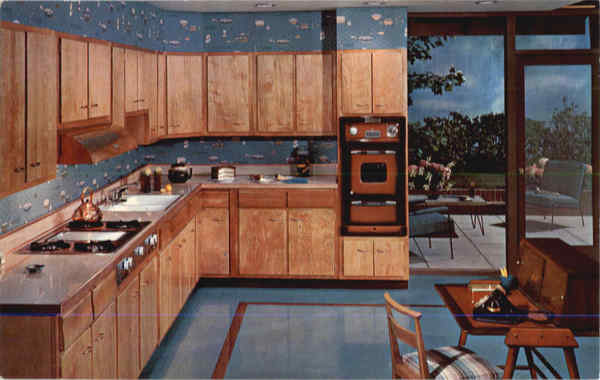How to Install Over the Range Microwave Without a Cabinet?

Installing an over-the-range microwave without a cabinet can be a daunting task, but with the right guidance and tools, it can be a manageable home-improvement project.
In this guide, we will take a look at five different methods of how to install an over-the-range microwave without a cabinet: wall-mounting, suspending, countertop placement, under-cabinet mounting, and built-in installation.
We will provide a step-by-step guide for each method, along with the tools needed to complete the installation. By the end of this guide, you will have a better understanding of the different options available and will be able to choose the best method for your specific situation.
You'll Learn About
How to Install Over the Range Microwave Without a Cabinet?
The most efficient method for installing an over-the-range microwave without a cabinet will depend on your specific situation and personal preferences. However, here are some pros and cons of each method to help you decide:
Method 1: Wall-mounting
This is the most common method for installing an over-the-range microwave without a cabinet. It is relatively easy to install and does not require any additional space or hardware. However, it can be difficult to clean behind the microwave and it may be more visible than other methods.
Method 2: Suspending
This method is a good option if you want to save space and make the microwave less visible. It is easy to install and does not require any additional space or hardware. However, it can be difficult to access the microwave for cleaning or maintenance and it may not be as secure as other methods.
Method 3: Countertop Placement
This method is a good option if you have a small kitchen or limited space. It is easy to install and does not require any additional hardware. However, it can be difficult to access the microwave for cleaning or maintenance and it may not be as secure as other methods.
Method 4: Under-cabinet Mounting
This method is a good option if you have a cabinet above the stove that you can use to mount the microwave. It is easy to install and does not require any additional space or hardware. However, it can be difficult to access the microwave for cleaning or maintenance and it may not be as secure as other methods.
Method 5: Built-in Installation
This method is a more complex option that requires professional installation. It gives your kitchen a sleek and seamless look, but it is more expensive and time-consuming than other methods.
Ultimately, the most efficient method will depend on your specific needs and preferences. If you want a sleek and seamless look, built-in installation may be the best option. However, if you want a quick and easy installation with minimal cost, wall-mounting or countertop placement may be the best option.
Tools Needed
Here are some of the tools that may be needed when installing an over-the-range microwave without a cabinet:
- Drill: Used to drill holes in the wall or cabinet for mounting hardware.
- Screwdriver: Used to tighten screws and secure the mounting hardware.
- Level: Used to ensure the microwave is level and plumb when installed.
- Stud finder: Used to locate the studs in the wall for wall-mounting or under-cabinet mounting.
- Wire hanger: Used to suspend the microwave.
- Saw: Used to cut openings in the wall or cabinet for built-in installation.
- Drywall knife: Used to finish drywall around the recessed space for built-in installation.
- Mounting hardware: Specific hardware that comes with the microwave to mount it.
- Measuring tape: Used to measure the space and make sure the microwave will fit.
Note: Always make sure to follow the manufacturer’s instructions when installing an over-the-range microwave and consult a professional if you are not comfortable with the process.
Method 1: Wall-mounting
- Gather the necessary tools: You will need a drill, screwdriver, level, stud finder, and the mounting hardware that came with your microwave.
- Unpack the unit and set up the area: Make sure you have enough space to work and that the area is clean and clear of any debris.
- Locate the studs: Use a stud finder to locate the studs in the wall where you want to mount the microwave. Make sure the studs are level and in the right position to support the weight of the microwave.
- Mark the studs: Use a pencil to mark the studs where you will be attaching the mounting hardware.
- Assemble the mounting bracket: Follow the instructions that came with your microwave to assemble the mounting bracket. Make sure the bracket is level and secure.
- Attach the bracket to the wall: Use the drill and screws to attach the bracket to the wall, making sure to line up the bracket with the marks you made on the studs.
- Place the microwave on the bracket: Carefully place the microwave on the bracket, making sure it is level and secure.
- Connect the power: Connect the power cord to the outlet and plug in the microwave.
- Test the microwave: Turn on the microwave and test it to make sure it is working properly.
- Clean up: Dispose of any packaging materials and clean up the area.
Note: Always make sure to follow the manufacturer’s instructions when installing an over-the-range microwave and consult a professional if you are not comfortable with the process.
Method 2: Suspending
- Gather the necessary tools: You will need a drill, screwdriver, level, wire hanger, and the suspension hardware that came with your microwave.
- Unpack the unit and set up the area: Make sure you have enough space to work and that the area is clean and clear of any debris.
- Locate the studs: Use a stud finder to locate the studs in the wall where you want to suspend the microwave. Make sure the studs are level and in the right position to support the weight of the microwave.
- Mark the studs: Use a pencil to mark the studs where you will be attaching the suspension hardware.
- Assemble the wire hanger: Follow the instructions that came with your microwave to assemble the wire hanger. Make sure the hanger is level and secure.
- Attach the hanger to the wall: Use the drill and screws to attach the hanger to the wall, making sure to line up the hanger with the marks you made on the studs.
- Suspend the microwave: Carefully lift the microwave and place it onto the wire hanger, making sure it is level and secure.
- Connect the power: Connect the power cord to the outlet and plug in the microwave.
- Test the microwave: Turn on the microwave and test it to make sure it is working properly.
- Clean up: Dispose of any packaging materials and clean up the area.
Note: Always make sure to follow the manufacturer’s instructions when installing an over-the-range microwave and consult a professional if you are not comfortable with the process. Also, make sure the wire hanger is strong enough to support the weight of the microwave.
Method 3: Countertop Placement
- Gather the necessary tools: You will need a level and the hardware that came with your microwave.
- Unpack the unit and set up the area: Make sure you have enough space to work and that the area is clean and clear of any debris.
- Measure the space: Measure the space above the stove where you want to place the microwave. Make sure the microwave will fit and that there is enough clearance for the vent hood.
- Assemble the microwave: Follow the instructions that came with your microwave to assemble it.
- Place the microwave: Carefully place the microwave on the countertop or shelf above the stove, making sure it is level.
- Connect the power: Connect the power cord to the outlet and plug in the microwave.
- Test the microwave: Turn on the microwave and test it to make sure it is working properly.
- Clean up: Dispose of any packaging materials and clean up the area.
Note: Always make sure to follow the manufacturer’s instructions when installing an over-the-range microwave and consult a professional if you are not comfortable with the process. Also, make sure the countertop or shelf is strong enough to support the weight of the microwave.
Method 4: Under-cabinet Mounting
- Gather the necessary tools: You will need a drill, screwdriver, level, and the mounting hardware that came with your microwave.
- Unpack the unit and set up the area: Make sure you have enough space to work and that the area is clean and clear of any debris.
- Measure the space: Measure the space under the cabinet where you want to mount the microwave. Make sure the microwave will fit and that there is enough clearance for the vent hood.
- Assemble the mounting bracket: Follow the instructions that came with your microwave to assemble the mounting bracket. Make sure the bracket is level and secure.
- Attach the bracket to the cabinet: Use the drill and screws to attach the bracket to the bottom of the cabinet, making sure it is level.
- Place the microwave on the bracket: Carefully place the microwave on the bracket, making sure it is level and secure.
- Connect the power: Connect the power cord to the outlet and plug in the microwave.
- Test the microwave: Turn on the microwave and test it to make sure it is working properly.
- Clean up: Dispose of any packaging materials and clean up the area.
Note: Always make sure to follow the manufacturer’s instructions when installing an over-the-range microwave and consult a professional if you are not comfortable with the process. Also, make sure the cabinet is strong enough to support the weight of the microwave.
Method 5: Built-in Installation
- Gather the necessary tools: You will need a drill, screwdriver, level, saw, drywall knife, and the mounting hardware that came with your microwave.
- Measure the space: Measure the space where you want to install the built-in microwave. Make sure it will fit in the space and that there is enough clearance for the vent hood.
- Prepare the area: Remove any drywall or cabinetry as needed to create an opening for the microwave.
- Install the framing: Install framing to create a recessed space for the microwave. Make sure the framing is level and secure.
- Install the microwave: Carefully place the microwave into the recessed space and secure it with the mounting hardware.
- Connect the power: Connect the power cord to the outlet and plug in the microwave.
- Test the microwave: Turn on the microwave and test it to make sure it is working properly.
- Finish the drywall: Use drywall compound and a drywall knife to finish the drywall around the recessed space.
- Finish the cabinetry: Install any cabinetry or trim around the microwave to give it a seamless look.
- Clean up: Dispose of any packaging materials and clean up the area.
Note: Always make sure to follow the manufacturer’s instructions when installing an over-the-range microwave and consult a professional if you are not comfortable with the process. Built-in installation is a complex process and should only be done by professionals.
Tips You Need to Follow While Installing Microwave
Check the Dimensions
Before purchasing an over-the-range microwave, make sure to measure the space where you plan to install it. This will ensure that the microwave will fit in the space and that there is enough clearance for the vent hood.
Check the Venting
If you are planning to use the over-the-range microwave for venting, make sure to check the venting requirements for your specific model. Some microwaves may require a separate vent hood, while others may have built-in venting capabilities.
Check the Power Requirements
Make sure the outlet you plan to use for your over-the-range microwave is properly grounded and can handle the power requirements of the microwave. If necessary, hire an electrician to install a dedicated circuit for the microwave.
Consider the Height
Consider the height of the microwave in relation to the stove. You want to be able to reach the microwave comfortably and avoid having to stretch or bend to use it.
Consider the Style
Over-the-range microwaves are available in a variety of styles and finishes. Consider the style of your kitchen and choose a microwave that will complement your existing decor. Scheirich Cabinets are some of the good Quality.
Read the Manual
Make sure to read the manual and understand the features of your microwave before installing it. This will help you understand how to use it safely and properly.
Take Your Time
Installing an over-the-range microwave can be a time-consuming task. Don’t rush and take your time to ensure a proper installation. Some people also like to drain the washer into the sink for less cost.
Final Words
Installing an over-the-range microwave without a cabinet can be a challenging task, but with the right guidance and tools, it can be a manageable home-improvement project.
We have discussed five different methods for installing an over-the-range microwave without a cabinet, including wall-mounting, suspending, countertop placement, under-cabinet mounting, and built-in installation.
Each method has its own set of pros and cons, and the best method for you will depend on your specific needs and preferences. Whether you choose to wall-mount, suspend, place on a countertop, under-cabinet mount, or built-in the microwave, always make sure to follow the manufacturer’s instructions and consult a professional if you are not comfortable with the process.
By taking the time to carefully plan and execute your installation, you will be able to enjoy your new microwave for many years to come.


